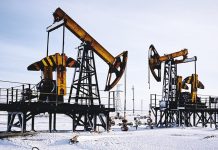By Brian Hoffman, CPA, CA
Natural-gas prices have shown some strength recently, piggy-backing on higher oil prices. Although last week’s higher than expected gas storage update is bearish in the short-term for natural-gas prices, the longer term outlook bodes well for significantly higher natural-gas prices.
Although oil prices will also probably pull-back from the recent run-up with the technical outlook turning bearish in the short-term if oil prices breach the US$50 support level, oil prices are likely to remain strong in the years ahead, which will help to support natural-gas prices.
Despite the current over-supply of natural-gas, the supply-demand situation is likely to achieve equilibrium over the next two years that will support higher long-term natural-gas prices. Supply has increased substantially primarily due to reduced industrial demand during the recession and a warmer than usual winter in the north east U.S. However, many natural-gas exploration and production companies have reduced their drilling plans for 2009, which will result in less gas going into storage over the next two years. The supply-demand fundamentals are expected to improve considerably when industrial demand starts to pick up in light of reduced drilling.
The energy equivalency of natural-gas compared to oil is generally 6,000 cubic feet to one barrel of oil, and the price for 1,000 cubic feet (1 Mcf) will generally trade for one-sixth of the price for one barrel of oil during normal times. As you are well aware, we are definitely experiencing anything but normal times in the current environment.
Over the past two years oil has traded for about 10 to 12 times the price of natural-gas. With current prices for oil at about US$61 per barrel and natural-gas at about US$3.40 per Mcf, the ratio is almost 18 to 1. Natural-gas prices stand to benefit from closing the gap in pricing relative to oil prices.
Natural-gas prices have spiked twice in the past four years and accompanied spikes in oil prices – in 2005 after hurricane Katrina hit Louisiana and during last year’s run-up in prices. Another price spike could occur when the supply-demand outlook improves.
An opportunity to benefit from a recovery in natural-gas prices, particularly a price spike, is through the United States Natural Gas Fund (UNG: NYSE, $13.70), which invests in near-month natural-gas futures contracts.
In the chart below note the significant downtrend in the price of UNG over the past year. The downtrend is still intact but the price is ripe for a breakout later this year, which could set the stage for a significant trend reversal.

Over the past few months UNG’s chart has formed a right-angled broadening formation, which is an accumulation pattern. A buy-signal will be triggered if volume expands on a breakout above the top line in this formation, which is at about US$18. A breakout will be confirmed if the price moves 10 per cent above this top line – to about US$20.
A subsequent pull-back towards the top line of the formation, which would become a new support level, would offer a low-risk entry point. Although the gain from US$13.70 to US$18 is foregone, the US$18 entry level after a pull-back would reduce the risk of the investment considerably. Also, breakouts from these consolidation patterns are generally followed by substantially price increases, so the potential increase from the US$18 level is enormous.
Inflation is pending in the U.S. with the government “printing” money to save its economy. The U.S. dollar is expected to weaken relative to other currencies, including Canada’s petro-currency, and commodities – particularly oil and gold – are seen as hedges against inflation and a considerably weaker U.S. dollar. As a result, investors need to consider that higher commodity prices in U.S. dollar terms will likely be impacted by a weaker U.S. dollar.
In any event, the outlook bodes well for natural-gas prices beyond 2009 and UNG provides investors an opportunity to benefit from a recovery in natural-gas prices. The potential for the price discrepancy to close between gas and oil prices adds to the appeal of this investment opportunity.
Brian Hoffman, CA, CPA, is an affiliate of the Market Technicians Assoc. and a member of the Canadian Society of Technical Analysts (E-mail: bk.hoffman@rogers.com)







